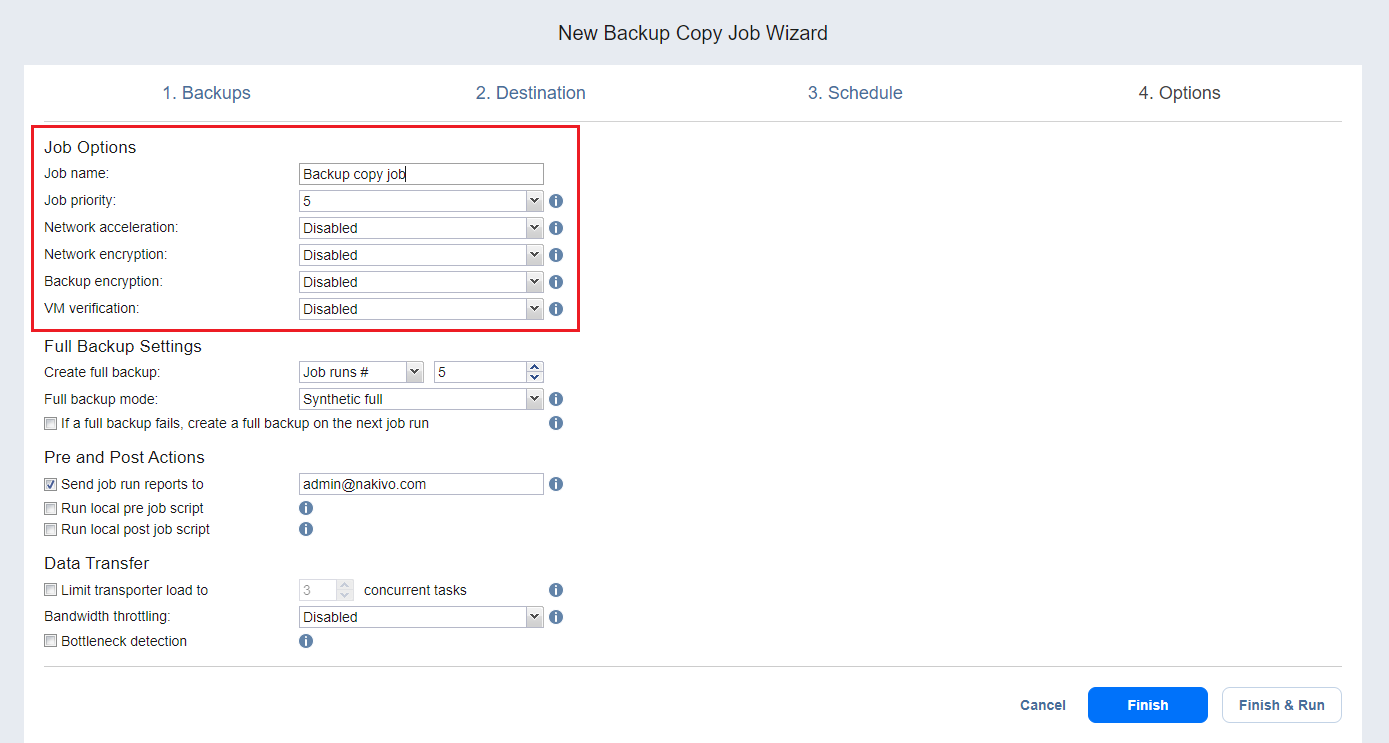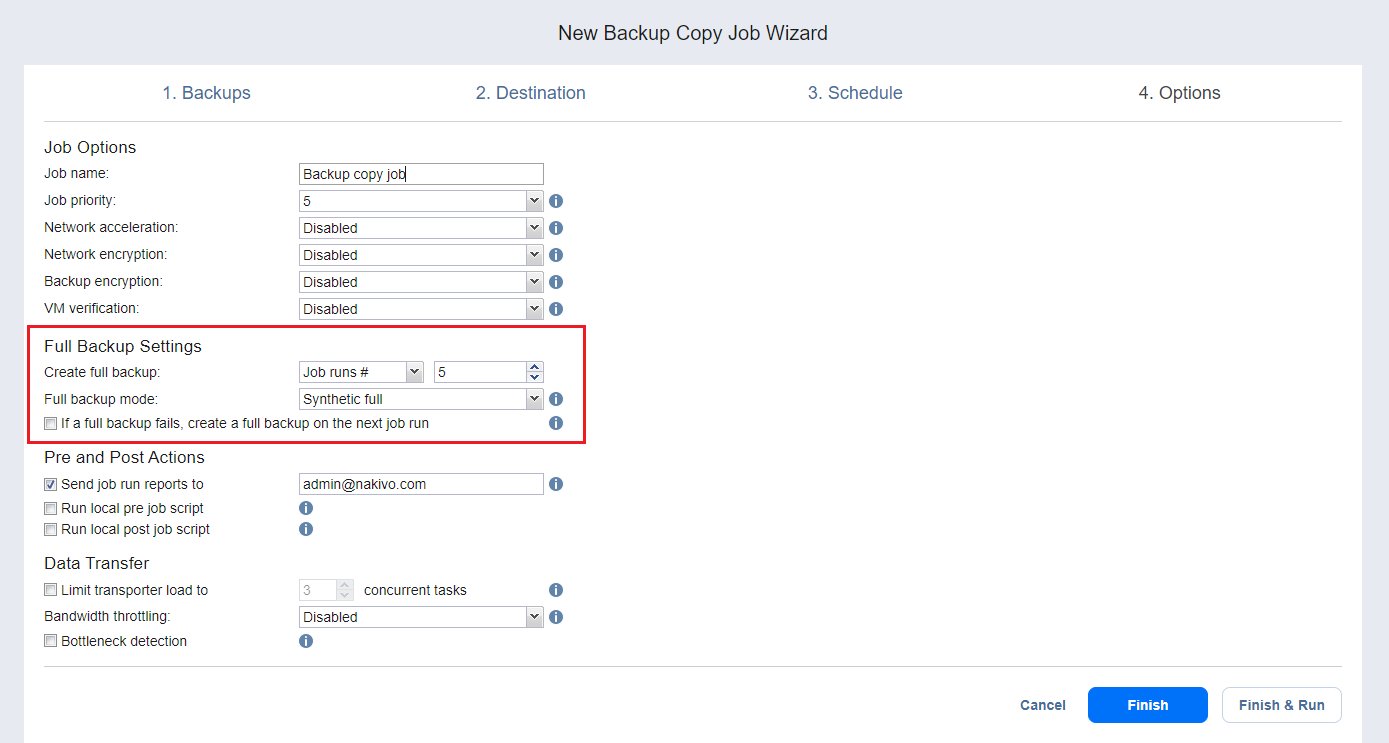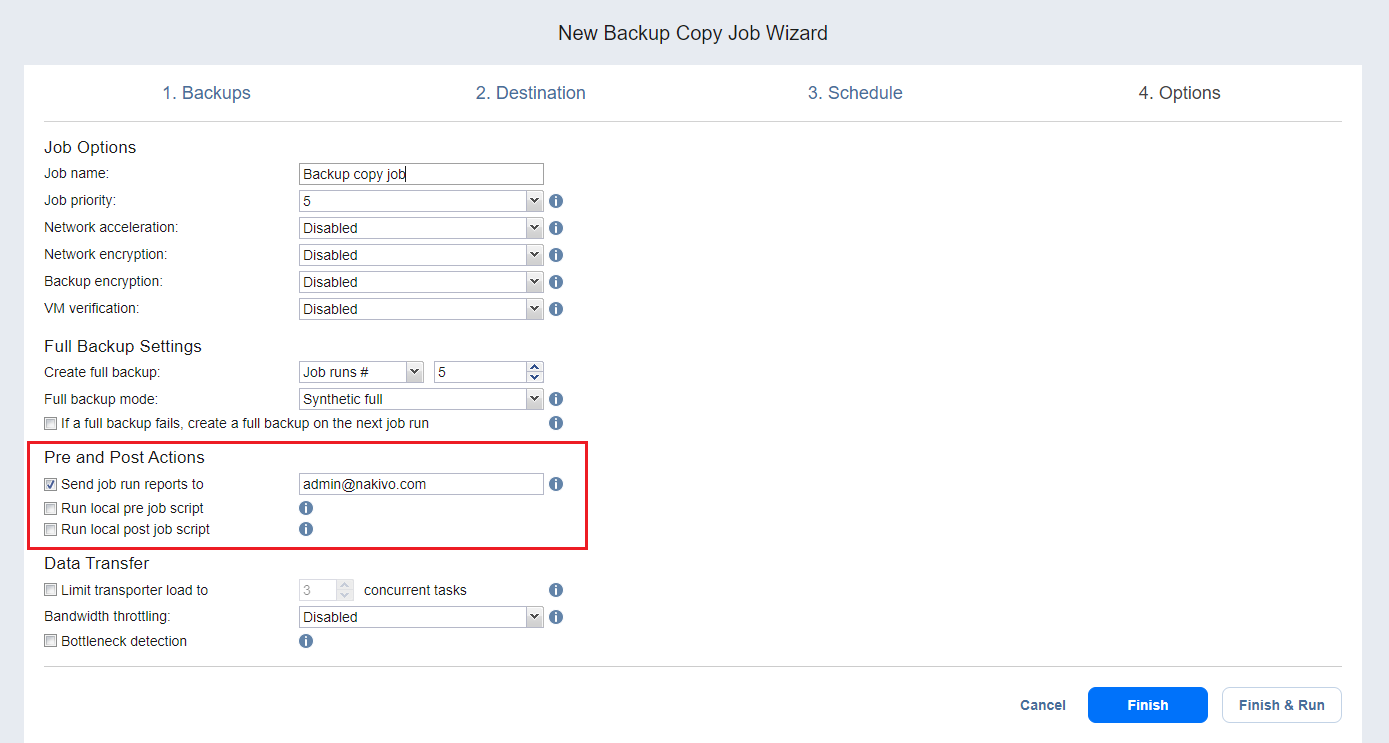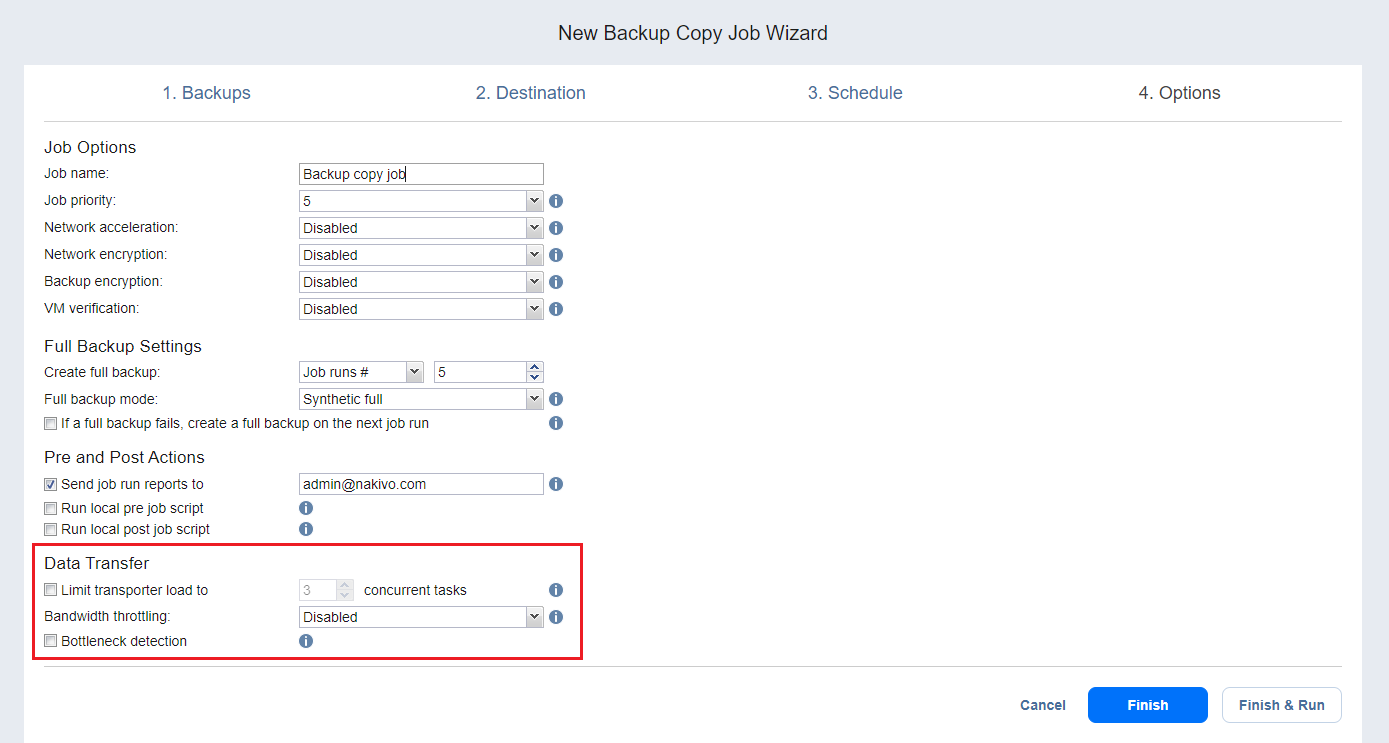Tape Backup Wizard: Options
On the Options page of the wizard, you can name the job and enable/disable network acceleration and encryption. In addition, you can set up pre and post actions and enable bandwidth throttling.
- Job Options
- Tape Backup Settings
- Pre and Post Job Actions
- Data Transfer
- Completing Tape Backup Wizard
Job Options
In this section, you can give a name to the tape backup job and enable/disable app-aware mode, change tracking, network acceleration, and encryption.
Job Name
Specify a name for the tape backup job in the Job name box.
Job Priority
Select a job priority level between 1 and 5, with 1 being the highest priority. Jobs with higher priority levels are prioritized by Transporters during job processing.
Notes
This option is only available in the Enterprise, Enterprise Essentials, Enterprise Plus, MSP Enterprise, and MSP Enterprise Plus editions.
If a tape backup job contains multiple backup objects, setting its Job Priority to 1 does not necessarily mean that the job finishes before lower priority jobs. This is because backup objects in Tape backup jobs are processed one by one, meaning that a Transporter is released after processing a given backup object. After the target tape cartridge for a subsequent backup object is found, a Transporter is assigned to the backup object with the highest priority.
Network Acceleration
Once Network Acceleration is enabled, NAKIVO Backup & Replication uses compression and traffic reduction techniques to speed up data transfer. Select this option if you are backing up over WAN without a VPN connection. For more information, refer to Network Acceleration. If the source backup is already compressed, it is recommended to enable Network Acceleration and make sure that the source Backup Repository and target tape device have the same compression level. For more information, see this article.
Note
The Network acceleration option is not available if the Backup encryption option is enabled.
Network Encryption
If the Network Encryption option is selected, backup data is protected with AES 256 encryption while traveling over the network. Data encryption increases the backup time and CPU load on machines running Transporters. Select this option if you back up over WAN without a VPN connection. For more information, refer to Encryption in Flight and at Rest.
Note
You need at least one Transporter at the source and target sites to enable network encryption.
Backup Encryption
When enabled, backup data is protected with AES 256 block cipher encryption with a 256-bit key length. You can protect the backup file by creating a new password or selecting an existing one.
For more information, refer to Enabling Backup Encryption.
Notes
This option is available only if the Disk or Tape destination type was chosen on the Destination page of the wizard.
The Backup encryption option is not available if the Network acceleration option is enabled.
If enabled, the created recovery points are encrypted.
The Backup encryption option is not displayed for a backup job where forever incremental repositories are selected as the only target repositories.
The Backup encryption option cannot be enabled if multiple targets with a mix of supported and unsupported (SaaS repositories or forever incremental repositories) repositories are selected as destinations.
It’s recommended that you enable the (AWS) Key Management Service. If KMS is enabled, all backup encryption passwords encrypted with the Key Management Service cryptographic key are available for recovery in case of product re-installation. For more information, refer to Enabling KMS.
Tape Backup Settings
In this section, select when you want the system to create full backups and set up the rules for data appending.
Creating Full Backup
With the Create full backup list, you can specify how often the system should perform a full (not incremental) backup to tape. The following options are available:
-
Always: Every backup will be full
-
Every: Select a day of the week. The full backup will be performed once a week on a specified day
-
Every 2nd: Select a day of the week. The full backup will be performed once in 2 weeks on a specified day
-
First: Select a day of the week. The full backup will be performed once per month starting with the first specified day of the month
-
Second: Select a day of the week. The full backup will be performed once per month starting with the second specified day of the month
-
Third: Select a day of the week. The full backup will be performed once per month starting with the third specified day of the month
-
Fourth: Select a day of the week. The full backup will be performed once per month starting with the fourth specified day of the month
-
Last: Select a day of the week. The full backup will be performed once per month starting with the last specified day of the month
-
Day #: Select the day number. The full backup will be performed once per month on the specified day number
-
Job runs #: Specify the number of backup jobs to pass before running a full backup
With the If a full backup fails, create a full backup on the next job run option selected, the next job run creates a full backup if the current job run fails to do so.
Note
Only Always and Job runs # options are always available for selection. The rest of the options' availability depends on the scheduling settings specified on the Schedule page.
Tape Appending
The Tape appending feature allows you to set up the rules for data appending. The following options are available:
-
Append previous tape if possible:
-
The job run appends data to the last tape cartridge.
-
If the tape cartridge that was last written during the last job run is not available in the device or is full, the job starts with an empty cartridge:
-
All job objects within the job run are written to the selected tape cartridge one by one.
-
If the selected tape cartridge runs out of space, the next empty tape cartridge is selected and the process repeats until all job objects are written.
-
-
-
Start full backup with an empty tape:
-
In case the backup modes of all job objects within the job run are defined as full:
-
The job run starts with an empty tape cartridge.
-
All job objects within the job run are written to the selected tape cartridge one by one.
-
If the selected tape cartridge runs out of space, the next empty tape cartridge is selected and the process repeats until all job objects are written.
-
-
In case the backup modes of all job objects within the job run are defined as incremental:
-
The job run appends data to the last tape cartridge.
-
All job objects within the job run are written to the selected tape cartridge one by one.
-
If the selected tape cartridge runs out of space, the next empty tape cartridge is selected and the process repeats until all job objects are written.
-
-
In case the backup modes of all job objects within the job run are defined as a mix of full and incremental modes:
-
The job run appends data to the last tape cartridge.
-
All job objects within the job run are written to the selected tape cartridge one by one.
-
If the selected tape cartridge runs out of space, the next empty tape cartridge is selected and the process repeats until all job objects are written.
-
-
-
Always start with an empty tape:
-
The job starts with an empty tape cartridge.
-
All job objects within the job run are written to the selected tape cartridge one by one.
-
In case the selected tape cartridge runs out of space, the next empty tape cartridge is selected and the process repeats until all job objects are written.
-
Pre and Post Job Actions
NAKIVO Backup & Replication provides you with the ability to enable certain actions before a tape backup job begins and after it has completed. You can choose to send job run reports to the email provided and run local pre and post job scripts.
Email Notifications
NAKIVO Backup & Replication can send email notifications on job completion status to specified recipients. This feature complements global notifications and provides you with the ability to configure notifications on a per-job level.
To enable this option, configure your Email settings.
To send email notifications, do the following:
-
In the Pre- and Post- Actions section, select the Send job run reports to option and specify one or more email addresses in the text box. Separate multiple email addresses with a semicolon.
Pre Job Script
To run a script before the product begins copying backups, do the following:
-
Place a script file on the machine on which the Director is installed.
-
In the Pre and Post Actions section, select the Run local pre job script option and click the settings link. Specify the following parameters in the dialog that opens:
- Script path: Specify a local path to the script on the machine on which the Director is installed. Script interpreter should be specified. Example (Windows): cmd.exe /c D:\script.bat
Example (Linux): bash /root/script.sh
-
Job behavior: Choose either of the following job behaviors in relation to script completion:
-
Wait for the script to finish: If this option is selected, tape backup will not be started until the script is completed.
-
Do not wait for the script to finish: If this option is selected, the product will run the script and will start copying backups at the same time.
-
-
Error handling: Choose either of the following job behaviors in relation to script failure:
-
Continue the job on script failure: If this option is selected, the job will perform tape backup even if the script has failed.
-
Fail the job on script failure: If this option is selected and the script fails, the job will be failed and tape backup will not be performed.
-
Post Job Script
To run a script after the product has finished copying all backups, do the following:
-
Place a script file on the machine on which the Director is installed.
-
In the Pre and Post Actions section, select the Run local post job script option and click the settings link. Specify the following parameters in the dialog box that opens:
- Script path: Specify a local path to the script on the machine on which the Director is installed. Script interpreter should be specified.
Example (Windows): cmd.exe /c D:\script.bat
Example (Linux): bash /root/script.sh
-
Job behavior: Choose either of the following job behaviors in relation to script completion:
-
Wait for the script to finish: If this option is selected, the job is in the “running” state until the script is completed.
-
Do not wait for the script to finish: f this option is selected, the job is completed even if the script execution is still in progress.
-
-
Error handling: Choose either of the following job behaviors in relation to script failure:
-
Continue the job on script failure: If this option is selected, script failure does not influence the status of the job.
-
Fail the job on script failure: If this option is selected and the script has failed, the job status is set to “failed” even if VM backup has been successful.
-
Important
Pre and post job scripts can be executed only on the machine where the Director is installed.
Data Transfer
In the Data Transfer section of the Options page, you can configure bandwidth throttling.
Bandwidth Throttling
Follow the steps below to regulate the speed of data transfer over the network for your tape backup job:
-
For the Bandwidth throttling option, choose Enabled.
Note
If bandwidth throttling is disabled for the current job, global bandwidth rules may still apply to your job. Refer to Bandwidth Throttling for details. -
Click the Settings link that becomes available.
-
The Job Bandwidth Rules dialog box opens displaying you the list of available rules. You have the following options:
-
Create a new bandwidth rule for your tape backup job:
-
Click the Create New Rule button.
-
The New Bandwidth Rule dialog box opens. Refer to Bandwidth Throttling for details on creating a bandwidth rule.
-
Click Save.
-
-
Activate an existing bandwidth rule for your job. Select the checkbox to the left of the necessary bandwidth rule. To deactivate a bandwidth rule for your job, clear the corresponding checkbox.
-
Edit a bandwidth rule. Click the Edit link for a bandwidth rule and modify it in the Edit Bandwidth Rule dialog box that opens.
-
Disable a bandwidth rule. Click the Disable link. The bandwidth rule is disabled for all jobs.
-
Remove a bandwidth rule. Click the Remove link and then click Delete to confirm your operation.
-
Bottleneck detection
When the Bottleneck detection option is enabled, additional information is collected and recorded in NAKIVO Backup & Replication logs in the course of data transfer for the purpose of bottleneck detection. Check this option to enable the Bottleneck detection capability of the physical machine agent engaged in the job.
Completing Tape Backup Wizard
Click Finish or Finish & Run to complete the job creation.
Note
If you click Finish & Run, you have to define the scope of your job. Refer to Running Jobs on Demand for details.




